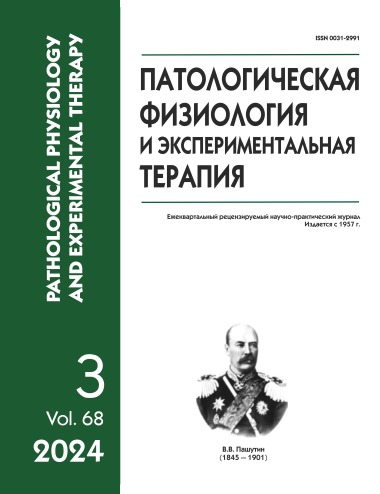Pathomorphological assessment of nonspecific toxic effect of hybrid organotin compounds in metronomic mode of administration
Abstract
Introduction. The effectiveness of standard antitumor therapy regimens is questioned due to lack of absolute specificity to tumor cells, the development of drug resistance, and severe side effects that are especially pronounced in patients with III and IV stages of malignant neoplasms. Metronomic administration of antitumor drugs can be successfully applied in palliative chemotherapy. Most research in the field of experimental chemotherapy focuses on the search for new agents, their combinations, doses, and administration modes that maximize the effect on tumor cells with minimal systemic toxicity. The aim of this study was to morphologically assess the nonspecific toxicity of the compounds with an alleged antitumor effect, bis–(3,5-di-tert-butyl-4-hydroxyphenyl) dimethyltin (Me-3) and (3,5-di-tert-butyl-4-hydroxyphenyl) triphenyltin (Me-5), when administered metronomically.
Methods. The study was performed on 8-week-old female C57Bl/6 mice weighing 21-22 g. Hybrid organotin compounds (Me-3 and Me-5) were administered metronomically for 10 days at a total dose of 375 mg/kg and 250 mg/kg, respectively. Control animals were injected with the carrier solution (1% gelatin solution). The tested compounds were administered intraperitoneally once a day. Guillotine euthanasia was performed 8 days after administration. The heart, liver, and kidneys were isolated for morphological study. Microscopic examination and photographic recording of histological sections was carried out at 20X magnification using a LEICA DM 4000 B light microscope. The presence or absence of dystrophic or inflammatory alterations and compensatory adaptive reactions was recorded.
Results. When administered metronomically, the effect of Me-3 and Me-5 compounds with an alleged antitumor effect did not produce significant, irreversible morphological changes in vital organs. This makes it advisable to further develop hybrid organotin compounds as chemotherapeutic agents for palliative therapy of malignant neoplasms in in vivo models.
Downloads
References
1. Tilljashajhov M. N., Kamyshov S. V. Features of palliative chemotherapy at the present stage (review). Colloquium-journal. 2020;12-2(64):23-28. doi: 10.24411/2520-6990-2020-11790 (in Russian)
2. Kweon S, Jeong YS, Chung SW, Lee H, Lee HK, Park SJ, et al. Metronomic dose-finding approach in oral chemotherapy by experimentally-driven integrative mathematical modeling. Biomaterials. 2022;286:121584. doi: 10.1016/j.biomaterials.2022.121584.
3. Parveen, S., Arjmand, F., Tabassum, S. Development and future prospects of selective organometallic compounds as anticancer drug candidates exhibiting novel modes of action. European Journal of Medicinal Chemistry. 2019;175:269-286. doi: 10.1016/j.ejmech.2019.04.062
4. Devi J., Boora A., Rani M., Arora T. Recent advancements in organotin (IV) complexes as potent cytotoxic agents. Anticancer Agents Med Chem. 2023;23(2):164-191. doi: 10.2174/1871520622666220520095549
5. Attanzio A., Ippolito M., Girasolo M.A., Saiano F., Rotondo A., Rubino S., et al. Anti-cancer activity of di- and tri-organotin(IV) compounds with D-(+)-Galacturonic acid on human tumor cells. J Inorg Biochem. 2018;188:102-112. doi: 10.1016/j.jinorgbio.2018.04.006
6. Milaeva E.R., Dodohova M.A., Shpakovskij D.B., Antonenko T.A., Safronenko A.V., Kotieva I.M. et al. Mechanisms of cytotoxic action of organotin compounds. Biomedicine. 2021;17(2):88-99. doi: 10.33647/2074-5982-17-2-88-99 (in Russian)
7. Dodohova M.A., Safronenko A.V., Kotieva I.M., Suhorukova N.V., Gancgorn E.V., Alhusejn-Kuljaginova M.S. и др. Assessment of the pharmacotherapeutic potential of organotin compounds in vivo. Russian Journal of Biopharmaceuticals. 2021;13(3):30-34. doi: 10.30906/2073-8099-2021-13-3-30-34 (in Russian)
8. Dodohova M.A., Safronenko A.V., Kotieva I.M., Komarova E.F., Trepel' V.G., Alhusejn-Kuljaginova M.S., Shpakovskij D.B., Milaeva E.R. Investigation of acute oral toxicity of organotin compounds containing a fragment of 2,6-di-tert-butylphenol. Ural Medical Journal. 2021;20(3):73-77. https://doi.org/10.52420/2071-5943-2021-20-3-73-77 (in Russian)
9. Dodokhova MA, Safronenko AV, Kotieva IM, Alkhuseyn-Kulyaginova MS, Shpakovsky DB, Milaeva ER (2021) Impact of organotin compounds on the growth of epidermoid Lewis carcinoma. Research Results in Pharmacology 7(4): 81–88. https://doi.org/10.3897/rrpharmacology.7.71455
10. Dodokhova MA, Safronenko AV, Kotieva IM, Alkhuseyn-Kulyaginova MS, Shpakovsky DB, Milaeva ER (2022) Evaluation of the pharmacological activity of hybrid organotin compounds in a B16 melanoma model in the classical and metronomic administration modes. Research Results in Pharmacology 8(1): 85–93. https://doi.org/10.3897/rrpharmacology.8.76363
11. Kit O.I., Francijanc E.M., Kotieva I.M., Kaplieva I.V., Trepitaki L.K., Bandovkina V.A., Kozlova L.S., Pogorelova Ju.A., Rozenko L.Ja., Cherjarina N.D. Dynamics of the tissue system of plasminogen regulators in skin melanoma on the background of chronic pain in female mice. Translational Medicine. 2018; 5 (2): 38–46. (in Russian)
12. Kit O.I., Kotieva I.M., Francijanc E.M., Kaplieva I.V., Trepitaki L.K., Bandovkina V.A., Cherjarina N.D., Pogorelova Ju.A., Blikjan M.V. Neurotransmitter systems of the brain of female mice in the dynamics of the growth of malignant melanoma reproduced against the background of chronic pain. Pathogenesis. 2017; 15(4): 49-55. doi: 10.25557/GM.2018.4.9749 (in Russian)
13. Devi J, Boora A, Rani M, Arora T. Recent Advancements in Organotin(IV) Complexes as Potent Cytotoxic Agents. Anticancer Agents Med Chem. 2023;23(2):164-191. doi: 10.2174/1871520622666220520095549
14. Stefanizzi, V.; Minutolo, A.; Valletta, E.; Carlini, M.; Cordero, F.M.; Ranzenigo, A.; Prete, S.P.; Cicero, D.O.; Pitti, E.; Petrella, G.; et al. Biological Evaluation of Triorganotin Derivatives as Potential Anticancer Agents. Molecules 2023, 28, 3856. https://doi.org/10.3390/ molecules28093856
15. Liu Z, Tian Z, Lv J, Liu W, Ma Y, Hu M et al. Mechanism in bradycardia induced by Trimethyltin chloride: Inhibition activity and expression of Na+/K+-ATPase and apoptosis in myocardia. J Toxicol Sci. 2020;45(9):549-558. doi: 10.2131/jts.45.549
16. Lütt F, Ehlers L, Nizze H, Jaster R. Different characteristics of chronic dibutyltin dichloride-induced pancreatitis and cholangitis in mouse and rat. Hepatobiliary Pancreat Dis Int. 2020;19(2):169-174. doi: 10.1016/j.hbpd.2019.10.007
17. Mendes ABA, Motta NAV, Lima GF, Autran LJ, Brazão SC, Magliano DC et al. Evaluation of the effects produced by subacute tributyltin administration on vascular reactivity of male wistar rats. Toxicology. 2022;15;465:153067. doi: 10.1016/j.tox.2021.153067
18. S. He, P. Li and Z.-H. Li, Review on endocrine disrupting toxicity of triphenyltin from the perspective of species evolution: Aquatic, amphibious and mammalian, Chemosphere, https://doi.org/10.1016/j.chemosphere.2020.128711






